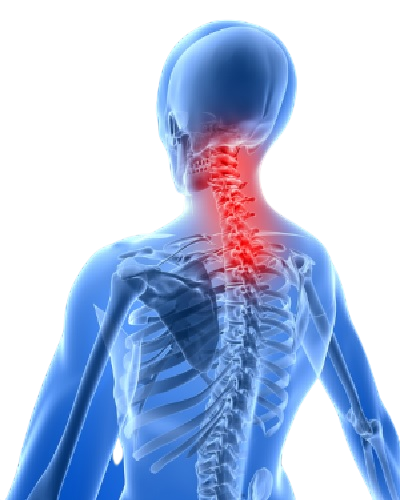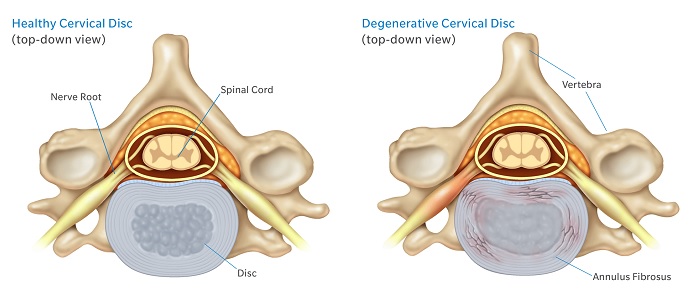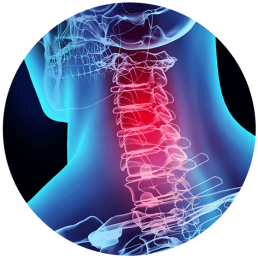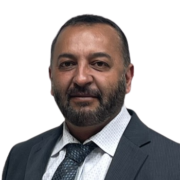Degenerative Cervical Spine Symptoms & Treatment
In the healthy neck, there is a disc filled with fluid between each bony element of the spine (vertebra). The disc helps to cushion the vertebrae from moving together under the weight of the head.
What is Degenerative Disc Disease?
When a disc degenerates (breaks down), the disc:
- Loses water. With less water, the disc becomes thinner and has less padding to absorb movement. The disc may become less flexible.
- Shrinks, which can narrow the space available for the nerve roots and spinal cord.
- May have tiny tears or cracks in its outer layer (annulus fibrosus).
As the disc deteriorates, the vertebrae may also begin to break down or touch.
Causes of Degenerated Discs in the Neck
Degeneration of the spine can start from over-use, an accident, or just the wear and tear of everyday life.
Symptoms of Degenerative Disc Disease
Depending on the amount of degeneration, patients with degenerative disc disease experience varied levels of pain, less neck motion, and weakness in the arms and hands. Not all disc degeneration results in pain or lack of mobility.
Disc degeneration can cause the:
- Inner disc (nucleus pulposus) to squeeze through the outer disc (disc bulge or disc herniation).
- Spinal canal to narrow and pinch the cord and nerves (spinal canal stenosis).
- Spinal cord to be irritated causing a loss of feeling or movement (myelopathy).
- Nerve roots to be irritated or pinched causing pain, weakness, or tingling down the arm and possibly into the hands (radiculopathy).
Degenerated Disc Diagnosis
Perform a physical examination by Dr. Martin, checking for range of motion and strength in your neck and arms. Your doctor will also order images of your neck: x-ray, MRI, or CT scan. In the images, your doctor will look for thinning discs, unhealthy bone growth, and pinching of the nerve roots and spinal cord.
Degenerative Disc Disease Treatment
The vertebrae and the discs allow a healthy cervical spine to:
- Bend side-to-side (lateral bend).
- Bend forward-to-back (flexion and extension).
- Turn left-to-right (rotation).
The surgery with Mobi-C:
There are good reasons, however, to choose an artificial disc. The Mobi-C may help end or lessen your pain and discomfort.
- Will replace your worn out, herniated, or damaged cervical discs.
- May help keep neck movement:
- Bending forward-to-back.
- Bending side-to-side.
- Turning left-to-right.
- Matches disc height to the levels above and below. This can help release (or free) trapped nerves.
- May lessen your neck and/or arm pain.
- May lessen any arm tingling.
- May help you return to your normal life of work, family, and fun.
More about Dr. Matin
Degenerative Disc Disease Treatment Options
Degenerative cervical spinal pain can be treated by Dr. Martin, give us a call to schedule an appointment.
We will provide different options of treatment.
Conservative Treatments
Conservative treatment is usually the first choice in the care of degenerative disc disease. Your doctor may suggest physical therapy, rest, anti-inflammatory medications, exercise, heat, and lifestyle changes. If conservative care does not help, if a nerve is pinched (compressed), or if the pain is severe, your doctor may recommend surgery.
Surgery Using the Mobi-C
Cervical Disc Replacement with Mobi-C: In a surgery with the Mobi-C Cervical Disc, the unhealthy disc is removed, but instead of a bone spacer or plastic implant along with a plate and screws, a Mobi-C is implanted into the disc space. Where a fusion procedure is intended to eliminate motion at the surgery levels, the goal of a surgery with Mobi-C is to allow motion at those levels.






